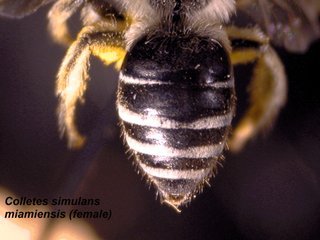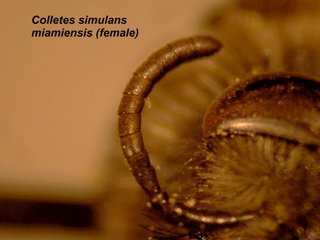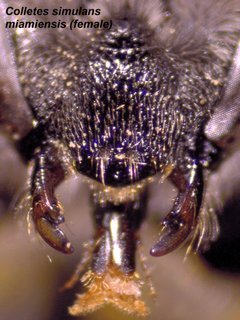|
| Links | Male Holotype of Colletes simulans miamiensis seen and scored at AMNH
- Hosts
|
80x5 -
240x3 -
240x4 -
320x1 -
320x2 -
320x3 -
640x1 -
640x2
Set display option above.
Click on
images to enlarge. |

© Copyright Laurence Packer 2014
· 7
Colletes simulans MALE CFP f |

Michael Veit · 6
Colletes simulans, f on Solidago -- |
|

Michael Veit · 6
Colletes simulans, m on Solidago |

Mitchell, Bees of the Eastern United States, Vol. I, 1960 · 1
Colletes simulans, figure10c |
|

John B. Pascarella · 1
Colletes simulans miamiensis, female, abdtop |

John B. Pascarella · 1
Colletes simulans miamiensis, female, antenna |
|

John B. Pascarella · 1
Colletes simulans miamiensis, female, headside |

John B. Pascarella · 1
Colletes simulans miamiensis, female, headtop |
|

John B. Pascarella · 1
Colletes simulans miamiensis, female, malarsp |

John B. Pascarella · 1
Colletes simulans miamiensis, female, mandible |
|

John B. Pascarella · 1
Colletes simulans miamiensis, female, mandibleclypeus |

John B. Pascarella · 1
Colletes simulans miamiensis, female, propodeum |
|

John B. Pascarella · 1
Colletes simulans miamiensis, female, prothoracicspines |

John B. Pascarella · 1
Colletes simulans miamiensis, female, prothoracicspines2 |
|
Overview |
Reprinted with permission from: Mitchell, T.B. 1960 Bees of the Eastern United States. North Carolina Agricultural Experiment Station Technical Bulletin No. 141.
FEMALE: Length 10-11 mm.; eyes convergent below; malar space evident, but very short; facial foveae very small and narrow, adjacent to upper end of eye; antennae blackish, length and breadth of median segments subequal; clypeus closely, striately and rather coarsely punctate; punctures rather sparse on supraclypeal area; pubescence greyish-white or faintly yellowish, intermixed with fuscous on upper portions of head and thorax; prothoracic spines well developed; metapleural protuberance not carinate; tegulae blackish; wings subhyaline, veins and stigma piceous; scutum dull, anterior half of disc rugose, posterior half with some scattered, sparse, irregular punctures; scutellum rather finely rugoso-striate, without distinct punctures; pleura dull, coarsely rugose; anterior coxal spines well developed; tarsi dark, mid and hind basitarsi about three times as long as broad, spurs yellowish-ferruginous; abdominal terga shining, closely, deeply and distinctly, but rather finely punctate, punctures well separated on basal tergum, becoming closer and finer on more apical segments; apical margins of terga dark, depressed toward sides, with white fasciae, inevident on 1st segment, interrupted medially on 2nd, entire on 3rd and 4th, 2nd with a basal white fascia, discal pubescence fuscous, but very short and inconspicuous.
MALE: Length 8-9 mm.; eyes convergent below; length of malar space about one-fourth its breadth; antennae brownish, length of median segments about one and a half times the breadth; clypeus closely punctate; pubescence greyish-white or faintly yellowish, intermixed with fuscous on upper portions of head and thorax; prothoracic spines well developed; metapleural protuberance not carinate; tegulae reddish-piceous; wings subhyaline, veins and stigma piceous; scutum somewhat shining, punctures rather coarse and deep, close over anterior portion, becoming sparse in center of posterior half; punctures of scutellum more coarse and deep, irregular and rather sparse; punctures of pleura somewhat finer, close and deep; tarsi somewhat reddened, basitarsi slender, spurs yellowish; abdominal terga shining, closely, deeply and distinctly but rather finely punctate, punctures well separated on basal tergum, becoming more close and fine on the more apical segments; apical margins of terga depressed, somewhat reddened, with entire white fasciae, discal pubescence fuscous, but very short and inconspicuous.
DISTRIBUTION: North Carolina and Georgia, north to Wisconsin, Michigan, New York and the New England states, into southern Canada; May to November.
FLOWER RECORDS: Aster, Baccharis, Eupatorium, Polygonum cuspidatum and Solidago. Robertson (1929) lists the following as host plants: Aster ericoides, Bidens aristosa, Cicuta maculate, Polygonum hydropiperoides, Solidago canadensis, S. graminifolia, S. nemoralis, and S. ulmifolia.
|
|
|
Identification | |
Extracted from: Charles, R. (1895). Notes on bees, with Descriptions of New Species. Transactions of the American Entomological Society Vol. 22, No. 2. pp. 115-128.
Appears as Colletes armata.
Cresson's Catalogue does not give the synonyms of Patton's paper, for which reason I did not know of them, and re-described this species
and the next. All of the males which I have seen have some black or fuscous hairs on the thorax above, which leads me to suspect that the males referred to this species by Patton do not belong to it. I have seen an example of the type of C. scitula and regard it as the male of this Colletes.
|
|
|
Names | |
|
|
| Supported by | |
Updated: 2024-07-27 01:13:03 gmt
|